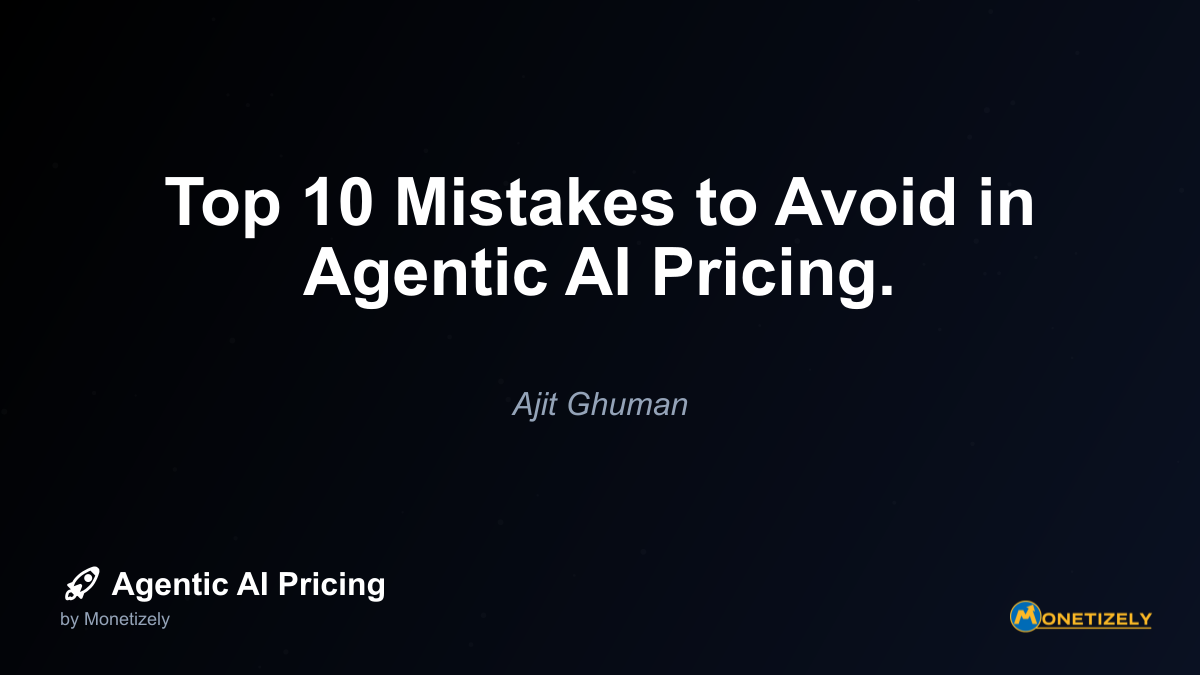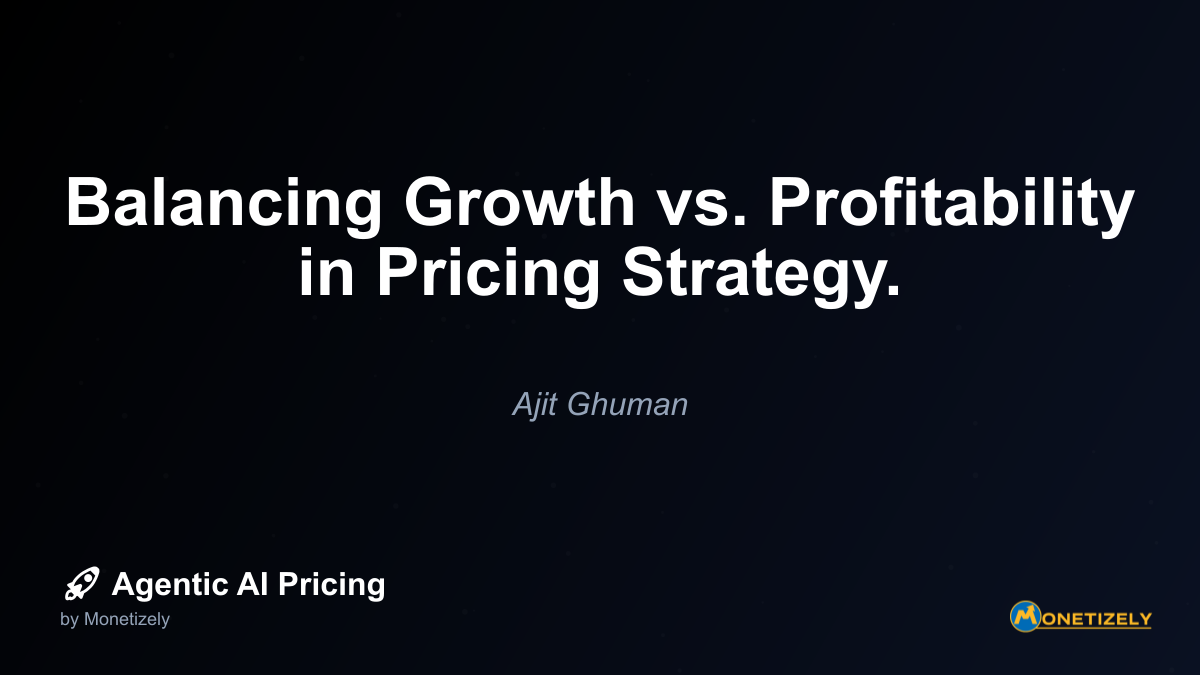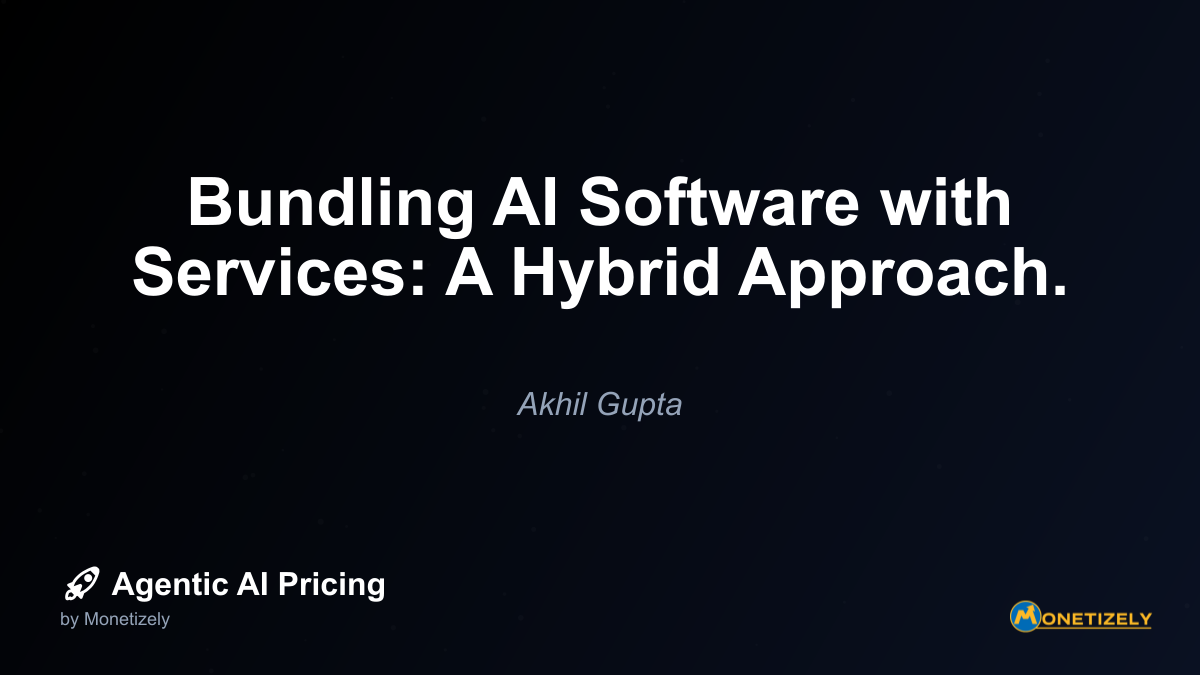· Ajit Ghuman · Strategy & Planning · 6 min read
Top 10 Mistakes to Avoid in Agentic AI Pricing.
AI and SaaS Pricing Masterclass
Learn the art of strategic pricing directly from industry experts. Our comprehensive course provides frameworks and methodologies for optimizing your pricing strategy in the evolving AI landscape. Earn a professional certification that can be imported directly to your LinkedIn profile.

Effective pricing requires ongoing competitive intelligence and clear positioning strategy. This includes:
- Regular analysis of direct competitors’ pricing models and value propositions
- Monitoring of market trends and emerging pricing approaches
- Clear articulation of how your pricing reflects your unique value and market position
- Strategic decisions about whether to compete on price, features, specialization, or other dimensions
Companies with successful pricing strategies deliberately position their offerings through pricing, using it as a communication tool that reinforces their desired market perception.
8. Underestimating the Importance of Pricing Communication
Even well-designed pricing strategies can fail when companies don’t effectively communicate the value and rationale behind their pricing to customers. This communication gap leads to resistance, confusion, and missed opportunities.
Common communication mistakes include:
- Focusing on features rather than outcomes: Technical descriptions of AI capabilities rather than the concrete benefits they deliver.
- Using technical jargon in pricing pages: Complex terminology that obscures the value proposition for non-technical decision-makers.
- Failing to provide clear ROI calculations: Not helping customers understand how the investment translates to business value.
- Inconsistent messaging across touchpoints: Different value narratives from sales teams versus marketing materials or product documentation.
Effective pricing communication requires:
- Clear, benefit-focused messaging that connects features to outcomes
- Transparent explanation of how pricing aligns with value delivery
- Case studies and ROI examples that make the value concrete
- Consistent training for sales and customer success teams on communicating pricing
Companies that excel at pricing communication treat it as an integral part of their pricing strategy, not an afterthought. They recognize that how pricing is presented significantly impacts customer perception and purchasing decisions.
9. Neglecting Post-Purchase Value Demonstration
A critical but often overlooked mistake is failing to demonstrate value after the purchase. This oversight can lead to higher churn rates, resistance to renewals or upgrades, and missed expansion opportunities.
This mistake typically manifests as:
- Limited visibility into usage and value metrics: Customers can’t easily see how much value they’re deriving from the AI agent.
- Insufficient onboarding to ensure value realization: Without proper implementation guidance, customers may not fully utilize the capabilities they’ve purchased.
- Weak ongoing value communication: Failure to regularly highlight the benefits being delivered and the ROI achieved.
- Reactive rather than proactive customer success: Engaging only when problems arise rather than continuously ensuring value delivery.
Leading companies implement robust value demonstration practices:
- Dashboards that visualize key value metrics and achievements
- Regular business reviews that quantify the impact delivered
- Proactive identification of opportunities to derive additional value
- Success stories and benchmarks that contextualize the customer’s results
This ongoing value demonstration creates a foundation for retention, expansion, and referrals. It also provides critical feedback for pricing strategy refinement by revealing which aspects of the solution deliver the most tangible value.
10. Failing to Evolve Pricing Strategy as Technology Matures
Perhaps the most strategic mistake is treating pricing as a static decision rather than an evolving strategy that must adapt as agentic AI technology and markets mature. This failure to evolve can leave companies with outdated pricing models that no longer align with market expectations or competitive realities.
Signs of this mistake include:
- Maintaining the same pricing structure despite significant product evolution: As AI capabilities expand, pricing should reflect new value dimensions.
- Ignoring shifts in customer expectations: As agentic AI becomes more mainstream, what customers consider premium versus standard features changes.
- Not adapting to commoditization of previously unique capabilities: Features that once commanded premium prices may become table stakes as the technology matures.
- Failing to capitalize on new monetization opportunities: Emerging use cases or integration possibilities may present new pricing models.
Forward-thinking companies establish regular pricing strategy reviews that consider:
- Technology evolution and its impact on value delivery
- Changing competitive landscape and pricing norms
- Emerging customer needs and use cases
- New opportunities for differentiation and value capture
By treating pricing as a dynamic strategy rather than a fixed decision, companies can maintain alignment between their pricing approach and the evolving reality of the agentic AI market.
Implementing a More Strategic Approach to Agentic AI Pricing
Avoiding these ten common mistakes requires a deliberate, strategic approach to pricing. Companies that excel in agentic AI pricing typically implement several key practices:
Cross-functional pricing teams: Including perspectives from product, finance, marketing, sales, and customer success ensures comprehensive consideration of pricing implications.
Regular pricing reviews: Quarterly or bi-annual structured evaluations of pricing performance against objectives, with defined metrics for success.
Customer research: Ongoing studies of willingness to pay, value perception, and competitive alternatives to inform pricing decisions.
Usage analytics: Detailed analysis of how customers use the AI agent to identify value patterns and potential pricing optimizations.
Experimentation: Controlled testing of pricing changes with segments of the customer base to validate assumptions before broader implementation.
Clear pricing ownership: Designated responsibility for pricing strategy, typically housed in product management or a dedicated pricing function.
By implementing these practices and avoiding the ten common mistakes outlined in this article, companies can develop pricing strategies for agentic AI products that drive adoption, ensure sustainable growth, and maximize customer value realization.
Conclusion
Pricing agentic AI products presents unique challenges that require thoughtful strategy and ongoing refinement. By avoiding the ten common mistakes outlined in this article—from undervaluing true costs to failing to evolve pricing as technology matures—companies can develop more effective pricing approaches that support their business objectives while delivering clear value to customers.
The most successful pricing strategies balance multiple considerations: they reflect the full cost structure of AI development and operation, communicate value clearly to customers, align with market positioning and competitive realities, and adapt as both technology and markets evolve.
As agentic AI continues to transform industries and create new possibilities, pricing strategy will remain a critical lever for commercial success. Companies that approach pricing with strategic intent, customer focus, and adaptability will be best positioned to capture the full value of their innovations while building sustainable businesses in this emerging field.
For pricing strategists and business leaders navigating these challenges, the key takeaway is clear: pricing is not a one-time decision but an ongoing strategic process that requires continuous attention, analysis, and refinement. By avoiding these common mistakes and implementing more thoughtful approaches, companies can turn pricing into a competitive advantage in the rapidly evolving agentic AI landscape.
To learn more about strategic approaches to agentic AI pricing, explore our in-depth guide on pricing your first agentic AI product, which provides a comprehensive framework specifically designed for founders and pricing leaders.
Co-Founder & CEO
Ajit is the author of Price To Scale, a top book on SaaS Pricing and is the Founder of Monetizely. Ajit has led and worked in pricing and product marketing at firms like Twilio, Narvar and Medallia. His work has been featured in Forbes and VentureBeat. Ajit regularly consults with software companies from Seed stage to post-IPO on pricing strategy. Ajit is also a highly-rated co-instructor for 'The Art of SaaS Pricing and Monetization' on Maven.
Pricing Strategy Audit
Let our experts analyze your current pricing strategy and identify opportunities for improvement. Our data-driven assessment will help you unlock untapped revenue potential and optimize your AI pricing approach.




